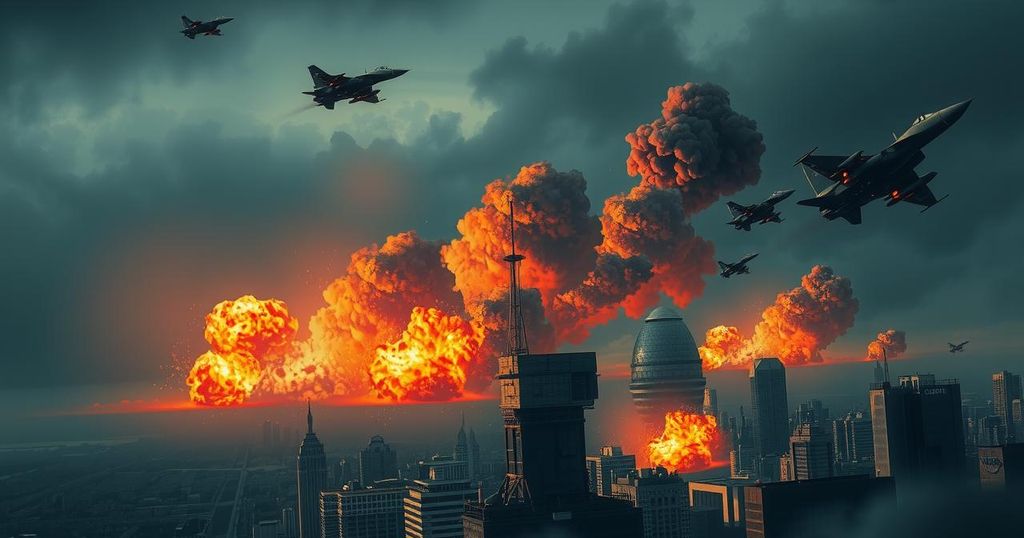11 Days in June: Trump’s Path to ‘Yes’ on Bombing Iran

In just eleven days this June, President Trump vacillated between diplomatic overtures and aggressive military posturing regarding Iran’s nuclear program. Following a series of attacks launched by Israel, U.S. forces joined in, marking a significant and controversial escalation in U.S. military involvement. The developments have raised pressing concerns about the implications for peace in the Middle East.
In just over a week, President Donald Trump kept the world guessing about whether he would support military action against Iran, particularly following Israel’s airstrikes aimed at crippling the nation’s nuclear ambitions. This past weekend, however, that speculation turned into reality as U.S. stealth bombers, fighter jets, and submarines launched attacks on Iranian targets, a move considered one of Trump’s most controversial foreign policy decisions, potentially reigniting conflict in the Middle East without a clear strategy for resolution.
Though the buildup was unpredictable, it unfolded largely on social media as Trump oscillated between advocating for diplomacy, issuing threats to the Iranian leadership, and ultimately endorsing military action. The following outlines this critical eleven-day timeline of events, with all times referenced in Eastern time.
Wednesday, June 11
A notable indicator of impending conflict arose when families of U.S. service members were ordered to evacuate the Middle East. Trump commented, “They are being moved out because it could be a dangerous place, and we’ll see what happens,” while attending a performance of “Les Misérables” in Washington. Speculation about Israel’s military intentions mounted, coinciding with ongoing diplomatic talks set to resume shortly, as Trump indicated a strong preference for a peaceful resolution.
Thursday, June 12
On this day, Trump suggested that an Israeli strike could happen soon, and shortly after, Tehran was rocked by explosions that targeted high-ranking military personnel and key nuclear sites. Israel reported that over 200 aircraft participated in the attacks, with drones effectively neutralizing Iranian air defenses. Prime Minister Netanyahu labeled it a “targeted military operation,” asserting it was essential for Israel’s survival, while Trump took to social media to profess commitment to a diplomatic solution, albeit in a wavering tone.
Friday, June 13
In retaliation, Iran fired missiles and drones back at Israel, with many being intercepted. Trump appeared increasingly impressed by Israel’s military capability, showcasing an aggressive stance toward Iran in his online messages. He contextualized his support for Israel, while still hinting at diplomatic opportunities for Iran. “Now they have, perhaps, a second chance,” he stated, signaling his desire for negotiations.
Saturday, June 14
Trump spoke with Russian President Vladimir Putin about the escalating tensions, as talks between the U.S. and Iran were canceled. Meanwhile, in Washington, Trump observed a military parade commemorating the Army’s 250th anniversary, showcasing America’s military strength against the backdrop of potential conflict.
Sunday, June 15
Trump sought to position himself as a peacemaker, stating via social media that many discussions were underway to foster peace in the region. Amidst ongoing airstrikes that had reportedly caused numerous casualties, federal officials reportedly dismissed a plan to assassinate Iran’s Supreme Leader Khamenei, viewing it as too hazardous.
Monday, June 16
Israel announced it had gained “aerial superiority” over Iran, conducting strikes against various targets, including state television. Trump, returning early from the G7 summit, met with national security advisors to discuss military options, emphasizing the internal pressures for decisive action against Iran.
Tuesday, June 17
Trump’s tone escalated as he called for Iran’s “UNCONDITIONAL SURRENDER,” expressing irritation with Iranian leaders when discussing the conflict. He openly disregarded contrary assessments from U.S. intelligence indicating Iran had not made moves toward nuclear weapons, insisting they were on the brink of doing so. In the early hours, he attended a Situation Room meeting without public appearance.
Wednesday, June 18
The question of whether Trump would join in Israel’s strikes on Iran was hanging heavy in the air. He vocalized uncertainty, asserting, “I may do it, I may not do it,” before later mentioning the potential for U.S. involvement in addressing Iran’s nuclear aspirations. Meanwhile, military options were being laid out for his consideration by defense leaders.
Thursday, June 19
Although it was a federal holiday, Trump maintained his rigorous schedule, with a press briefing revealing he would make a decision on military involvement within a fortnight. Observing Trump’s pattern of vague timelines, many were left guessing on next steps.
Friday, June 20
Continuing the drumbeat for military action, Trump met with national security advisors before heading to his New Jersey golf club. During this time, he dismissed previous claims made by his Director of National Intelligence concerning Iran’s nuclear intentions.
Saturday, June 21
In a midnight operation shrouded in secrecy, B-2 bombers took off towards Iran, with Trump returning to the White House soon after. The strikes commenced shortly thereafter as missiles and bombs rained down on Tehran, marking a dramatic escalation in U.S. involvement. Trump described the operation as a “very successful attack,” ominously threatening further military action if Iran retaliated.
Overall, the actions over these 11 days have set a precarious stage for Middle Eastern geopolitics, raising concerns over an uncertain future as tensions rise.
Trump’s decision-making process regarding military action against Iran has highlighted his unconventional approach to foreign policy, characterized by his fluctuating rhetoric between military threats and calls for diplomacy. Significant developments, such as the escalation of strikes from both Israel and the U.S., underscore the potentially perilous consequences of his actions, which could irrevocably shift dynamics in the Middle East. As the world watches closely, the upcoming days will prove crucial for the region’s stability or further escalation into conflict.
Original Source: apnews.com








